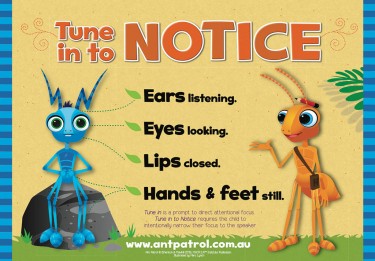Strategies to Support Impulse and Attention Control in the Classroom

| Posted: | September 18, 2015 |
| Author: | Deberea Sherlock Educational and Developmental Psychologist |
Share this article:
Strategies to Support Impulse and Attention Control in the Classroom
In keeping with the wider value of working collaboratively with families and schools, we bring to the Many Minds blog strategies to support impulse and attention control in the classroom. What sets the MASTER approach apart from commonly used behavioural management supports of impulse and attention control is (1) an emphasis on skill building that empowers parents with this knowledge base, coupled with (2) the provision of a shared language of support for both home and school (e.g. ‘tune in’ self-instructional scripts).
In contributing to a strong and purposeful collaboration between home and school, MASTER would like to share the following information with parents and teachers.
Impulse and Attention Control in the Classroom – General Principles of Support
Teachers know all too well that learning is based on a foundation of attention. If this foundation is compromised, learning becomes unstable at best. Knowing what to do, how to get started, what to concentrate on, what to filter out, and having the ability to sustain mental effort in performing these functions are often challenging for children with impulse and attention difficulties. It comes as no surprise that problems in attention control negatively affect classroom functioning and optimal learning outcomes.
Children-at-risk can be supported through inclusive educational management that is based on recognised principles of teaching practice. Key principles are outlined as follows:
- Establish positively framed classroom and school rules, clear routines and organisational structures;
- Explicitly teach classroom and school rules, routines and organisational structures;
- Determine an agreed upon purpose, structure, and schedule for regular home-school communication. Communication between home and school that acknowledges the complementary expertise of parent and teacher and a willingness to learn from each other is essential to an effective working alliance in support of the child;
- Present learning tasks with clarity, structure and sequencing of steps;
- Provide scaffolding when introducing new concepts or procedural components of tasks. Scaffolding involves explicit teaching, modelling, guided practice, independent practice, and consolidation with provision of rewards for effortful learning;
- Prime the child to use specific skill sets prior to the child commencing a task (e.g. the relevant skill sets introduced within the Ant Patrol® books and our MASTER Program include tune in to notice, tune in to your bounce, tune in to your self-talk, tune in to your helpful thinking, and tune in to focus);
- Provide time for self-reflection at the close of task where the child reflects on his/her use of skills;
- Provide feedback on performance (what skills were used well / what skills need further practice) with feedback emphasis placed on efforts rather than achievement; and
- Provide a positive learning setting that minimises distraction with scaffolds that support the child’s use of impulse and attention skills in context.
Support Focused Listening:
Children who experience impulse and attention control weakness typically have difficulty following multi-step instructions, appear not to listen, and are easily distracted. The following suggestions may be considered in support of focused listening:


• Keep instructions short and clear. Be prepared to repeat the message.
When giving whole class instructions ask a different child each time to repeat back to the class what the instruction was (e.g. John, what is it we have to do?).
Cue the child who requires support for focused listening by informing him/her that you will ask him/her to repeat the instruction back to the class (e.g. John, I will be asking you to tell the class what we have to do, so tune in to notice … give the instruction then ask the child to repeat the instruction to the class. Should the child have difficulty repeating the instruction, repeat but simplify the instruction. Use short, simple language and count items or actions of the instruction on your fingers. Provide pauses to allow processing.
When giving whole class instructions, count the items or actions of the instruction on your fingers and encourage children within your class to do the same when they are nominated to repeat the instruction back to the class.
• Consider providing information or instructions in both verbal and visual formats where possible to help children retain key details. The following visual formats may be useful:
♦Images;
♦Graphs and charts;
♦Mind maps;
♦Visual schedules;
♦Step planners;
♦Infographics;
♦Video presentations; and
♦Visual reference keys.
Support On-Task Behaviour:
Children with impulse and attention control weakness typically experience difficulty planning and organising their ideas and work, starting a task, maintaining attention to task, and completing the task. This can make effective participation in class very difficult. The following suggestions may be considered in support of on-task behaviour:
• Facilitate focused and productive work by providing quiet, distraction free zones within the classroom (e.g. individual work stations or carrels).

• For effective use of this plan, first consider the need for instructional scaffolding that makes explicit the specific strategies and procedural components of the task.
• Present the task with structure and sequenced ‘chunked down’ steps. This simple accommodation supports task initiation and motivation for effortful learning. Large tasks are simply overwhelming for many children who experience attention control weakness. Smaller tasks that have a clear end point help children get started and boost motivation for effortful work.
• In supporting focused and productive work, chunk down both task and time on task. Children are more likely to remain focused and persist with task completion when working for shorter periods of time.
• Provide short brain or movement breaks at the close of each task or ‘task chunk’ if necessary. You may consider providing a ‘movement’ zone within the classroom, or suggest an errand or drink break. After the break, children are encouraged to adjust bounce for their next task. When working to their plan, children are training their brains to maintain energised focus and productivity.
• Set children up for success by providing tasks of ‘medium effort’. ‘Big effort’ tasks are overwhelming and invite unhelpful thinking, off-task behaviours, or work avoidance. It is more helpful to provide two tasks of ‘medium effort’ than to give one ‘big effort’ task in supporting best efforts, persistence, and helpful thinking.
• Children may voice unhelpful thoughts that negatively impact upon their ability to persist with effortful tasks. Encourage children to use their helpful thinking to support engagement in the learning task (e.g. I’ve just caught your thought. You think this is too hard. Maybe you could say to yourself – even though this is hard, I can try my best and give it a go).
• Encourage children to monitor and check their work for accuracy and efficiency. Depending on age level, you may check for some or all of the following:
Is the job finished?
Does the answer make sense?
Check spelling, capitals, and punctuation.
• Children with attention control weakness expend considerable energy engaging attention and sustaining mental effort. Use specific feedback to praise children for skills and strategy use (e.g. Well done John, I could see you ignoring distractions and focusing on the task) with emphasis placed on efforts rather than achievement.
• Reinforce the practice and use of skills by rewarding effortful learning. This important support helps motivate children to learn and use otherwise un-motivating skill sets.
• Children may benefit from a set ‘reflection time’ with their teacher each day (3-5 minutes). In this time children can reflect positively on the use of their developing skills, identify what support is required and, if need be, negotiate workloads (e.g. reduction in the amount of work, time-extensions).
Support Motivation for Effortful Learning
Children who experience impulse and attention control weakness may display reduced motivation for effortful learning if their profile of difficulties includes a developmental weakness in maintaining an appropriate state of arousal or mental alertness. Children who display low motivation for effortful work require considerable scaffolding of focused listening, on-task work, and use of helpful thinking.
Although it is acknowledged that children vary in their motivation to learn, this particular pattern of behaviour represents a genuine developmental weakness for children who experience delays in a specific aspect of attention control (i.e. maintaining appropriate levels of arousal or alertness). It is developmentally difficult for some children to activate arousal to engage fully in work that is arduous, boring, or uninteresting. What makes this developmental difficulty especially puzzling for parents and teachers is the fact that arousal and mental alertness is without problem when these children are doing activities that are intrinsically motivating (e.g. Lego play or aspects of school work that the child likes). This apparent contradiction is in fact the way the Arousal System (one of three Attention Control Systems) actually works. Arousal is automatically activated for personally meaningful and motivating activities but arousal requires activation for effortful learning to enable children (and adults) to follow through and persist with arduous, boring or uninteresting work. Children with attention control weakness who experience this difficulty have a problem with their Arousal System. It can be easily misunderstood as laziness when in fact the Arousal System simply does not activate appropriately to maintain motivation for difficult work.
• It is important that we teach children to become aware of their thoughts and help them to understand that the content of their thoughts can have a critical impact on their performance, feelings, and learning and social behaviours. One of the key supports for low motivation for effortful learning is to help children develop helpful and productive ways of thinking in reframing unhelpful motivational states.
How do we do this? We teach the catchy 3C routine of tune in to your thinking.
When children perceive tasks to be challenging or effortful, encourage the use of the 3C’s as follows:
Catch: (Children are encouraged to intentionally think about thinking)
Teacher: What are you thinking?
Child: I don’t want to write. It’s hard. It’s boring.
Teacher: I’ve just caught your thought.
Check: (Children are encouraged to intentionally check their thought and to ask the question – is this thought helping me?)
Teacher: Is it a helpful or unhelpful thought? Is this thought helping you get the job done?
Child: Well, it’s not helping me to get started or get the job done so I guess it’s an unhelpful thought.
Change: (Children are encouraged to think in more helpful or productive ways)
Teacher: Use your helpful thinking. Can you think of a more helpful way of thinking that will help you – not stop you – from getting the job done?
Child: Writing is not so bad. When I finish I will feel good that I tried.
Teacher: Well done for using your helpful thinking. When you use your helpful thinking you usually manage to get through the tough times.
Further Considerations:
Should a child have difficulty changing to a more helpful way of thinking, you might offer some help as follows:
Teacher: You could say to yourself – Even though I don’t like writing, I can just do it.
Consider the possibility of co-occurring learning difficulties for those children who have particular difficulties adopting more helpful ways of thinking. Check the academic demands of a task and adjust accordingly.
Teach Organisational Skills:
Children with impulse and attention control weakness typically experience difficulty with the planning and organisational aspects of their day-to day and academic work. The following suggestions may be considered in supporting the development of organisational skills:
• The cooperative liaison between home and school is particularly important to children’s learning of organisational skills and strategies.
• Teach and model a variety of daily organisational systems and share this information with parents. These might include organising the schoolbag with specific pockets for lunch, permission slips and library book; organising schoolwork with colour-coded books; or organising desk and work area.
♦ Allocate time each day for organisation checks and review. This will allow children to draw upon common organisational templates in developing functional skills and strategies. Over time there will be a reduction in the need for direct teacher assistance as children internalise this learning.
• It remains beneficial to cue and/or evaluate different organisational strategies before the start of tasks.
♦ The use of step planners helps children develop a metacognitive perspective (i.e. awareness of the skills, strategies and steps involved in problem solving). Step planners outline all the steps involved in a task, reinforce verbal instructions, and reduce working memory demands. Step planners could be completed on the classroom whiteboard or a small whiteboard on a child’s desk, with an arrow or number to indicate each step. As a teacher provides instructions s/he could also write each step under an arrow.
A Note on Homework:
Homework can be a catalyst for tension between children with impulse and attention control weakness and their parents. The home-school liaison is especially important when dealing with homework challenges. Parents and teachers may agree to adjust quantity, content and expectations as necessary. The strategy of tune in to focus supports a positive approach to homework with both task and time on task chunked down coupled with self-instructional talk that directs focus, motivation for effort, persistence in carry through of task, and checking of work.
About the MASTER Institute
MASTER provides services, resources and guidance for parents, teachers and allied health professionals in supporting the social and emotional wellbeing of young children. Dr Deberea Sherlock and Aisling Mulvihill founded the MASTER Institute in 2012. From the combined professions of educational and developmental psychology and speech-language pathology, they bring to MASTER over 20 years of collective specialised experience in the area of children’s social and emotional development, and a deep understanding of children and the challenges they face. Their work is strongly guided by a desire to engage children through creative learning and the wider value of working collaboratively with families and schools.






